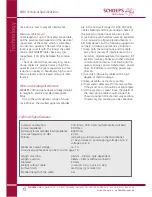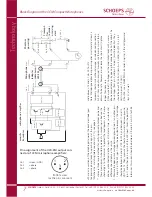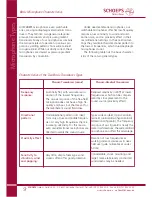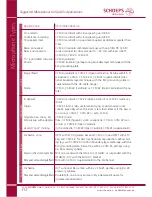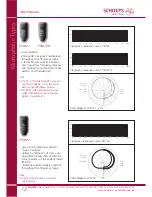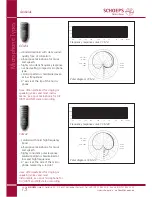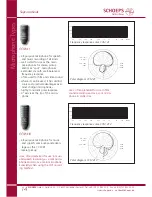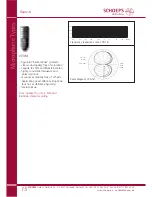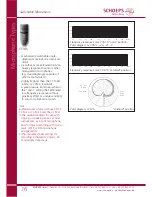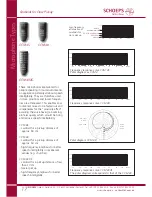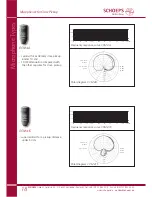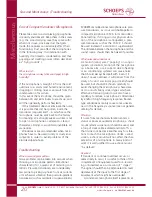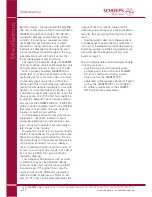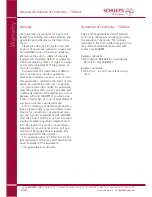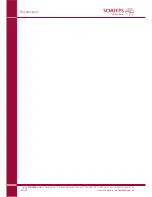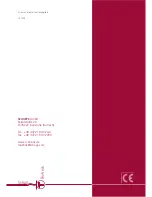
SCHOEPS
GmbH · Spitalstr. 20 · D-76227 Karlsruhe (Durlach) · Tel: +49 (0)721 943 20-0 · Fax: +49 (0)721 943 2050
www.schoeps.de · [email protected]
Care and Maintenance / Troubleshooting
20
Miscellaneous
Care of Compact Condenser Micro phones
Please take care to avoid placing microphones
in a dusty environment. Keep them in their cases
(e.g. the wood carrying case they come with)
when not in use, since any dust that gets
inside the capsules can adversely affect their
functioning. Dust can affect the microphones
in the following way: In combination with
humid ity it can lead to condensation and thus
popping and crackling noises (often described
as ”frying sounds”).
What to do if …
the microphone is noisy (clicks and pops) in high
humidity?
If the microphone is brought in from the cold
outdoors to a warm (and humid) environment,
snapping or clicking noises can result from the
condensation of moisture.
In this event the microphone should be given
between 30 and 60 minutes to warm up, and
will then generally perform flawlessly.
If this treatment does not eliminate the noise,
it is possible that dirt has gotten inside the
transducer (capsule) itself – in which case the
microphone must be sent back to the factory
for cleaning. We strongly advise customers not
to open a microphone or attempt to clean it
themselves. Doing so would also invalidate all
warranties.
Windscreens are recommended when micro-
phones have to be used in dirty or dusty envi-
ronments in order to avoid problems of the
kind described above.
Troubleshooting
Wind noise and polar pattern
Noise problems can be taken into account when
choosing a microphone pattern (directional
characteristic) for a given set of recording con-
ditions. Pressure transducers are considerably
less prone to picking up noise from air currents
or mechanical vibration than pressure-gradient
transducers (such as cardioids or supercardioids).
SCHOEPS
omnidirectional microphones are pres-
sure transducers, as is our switchable-pattern
compact microphone CCM 5 in its omnidirec-
tional setting. If strong wind or physical vibra-
tion of the microphone is anticipated, a pres-
sure transducer such as the CCM 2 S should
be used instead of a cardioid or supercardioid.
The distance between the microphone and the
sound source should then be halved if possible.
Wind noise and windscreens
Air motion (wind, vocal “popping” on sung or
spoken consonants, motion of the microphone
on a boom arm, or air currents due to heating
or air conditioning systems) can cause noise
that should always be dealt with. Even if it
doesn't cause overload, it will detract from the
clarity of sound. A wind or pop screen should
be used, but should be chosen carefully to
avoid changing the microphone's characteris-
tics too much. Many screen types which are
effective at reducing wind noise also have a
tendency to reduce a microphone's directional-
ity and/or its high-frequency response. Basket-
type windscreens mainly cause some uneven-
ness in the frequency response (see our general
catalog for details).
Vibration
If noise from mechanical vibration enters a
stand- or boom-mounted microphone, a shock
mount (elastic suspension) should be used, and
a loop of slack cable isolated and tied off so
that it does not become another way for vibra -
tions to reach the microphone. Unlike a wind
screen, a shock mount will not affect the char-
acteristics of a microphone. In many kinds of
work it is well justified to use a shock mount
”by default.”
Overload
If transient or continual overload occurs, or
seems likely to occur, it is useful to think of the
complete set of equipment used for a record-
ing or broadcast as a succession of ”stages.”
The signal should then be attenuated (its level
decreased) at the input to the first stage of
equipment which might be overloaded.
A condenser microphone itself represents at

